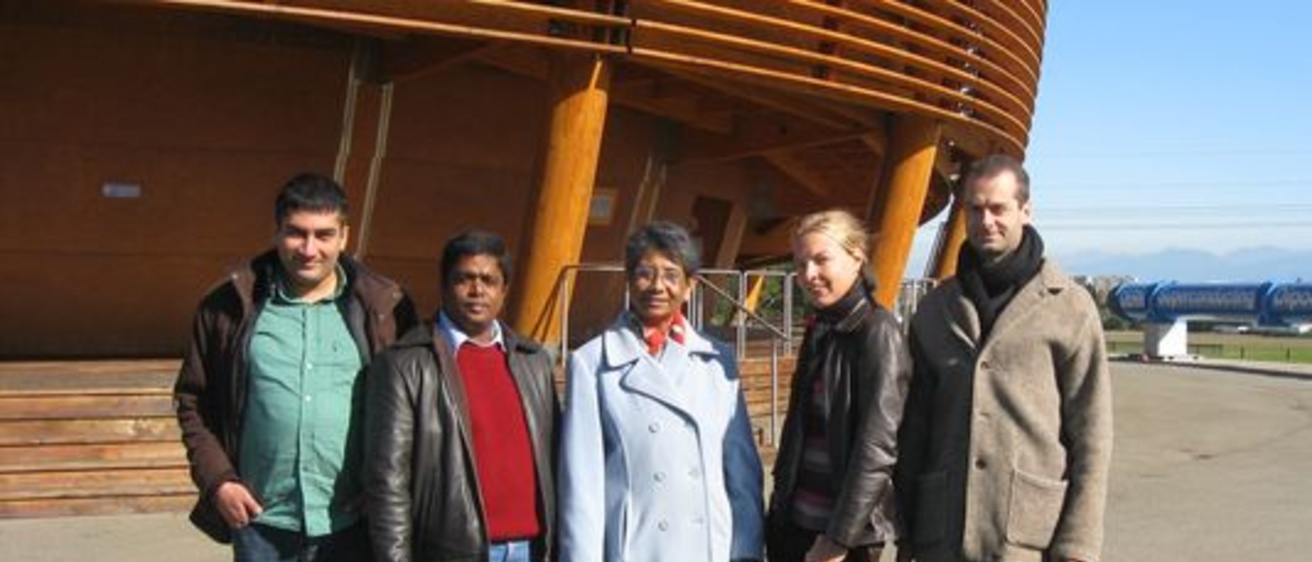From the Iowa City Press Citizen, March 29, 2015
Usha Mallik has spent a career trying to figure out exactly what happened during a few millionths of a billionth of an instant about 13.8 billion years ago.
The University of Iowa physics professor has been working for decades to account for all the factors at play in those femtoseconds after the Big Bang — the forces that set the stage for the universe we have now rather than for the infinite number of alternative universes that could have spun into being instead.
And with plans to soon restart the world's largest and most powerful particle accelerator, the Large Hadron Collider (LHC) at CERN in Switzerland, Mallik and her physicist colleagues across the state are anxiously awaiting the new data that will come from the large-scale experiments they oversee at the collider.
The hope is that — with the collider's energy level being raised to nearly double the level of two years ago — the experiments will lead to discoveries that challenge the current understanding of the universe.
Since the existence of sub-atomic quarks were confirmed in the mid-1970s, the results of such experiments have fit largely within what's called the Standard Model of particle physics. That model uses the forces of gravity and electromagnetism — along with weak and strong nuclear interactions — to explain the nature of reality.
Over the past two decades, the discoveries of other sub-atomic particles — such as the top quark in 1995, the tau neutrino in 2000 and, most recently, the Higgs boson (aka, the "God particle") in 2013 — have further confirmed the Standard Model as an effective explanation for, well, just about everything.
"(The Standard Model) has been almost frustratingly correct," Mallik said.
The problem with all that confirmation is that physicists and cosmologists know full well that, to paraphrase Shakespeare, "There are more things in heaven and earth than are dreamt of in the Standard Model."
The model doesn't explain:
• What happened to all the anti-matter in the universe — especially considering how matter and anti-matter were equally present at the beginning stages.
• Why gravity is such a weak force.
• Why the universe's expansion seems to be accelerating, rather than slowing down.
• Why we can't understand the identity of the dark matter that makes up a quarter of the universe.
The Standard Model isn't "wrong," Mallik said, any more than Newtonian or mechanical physics are "wrong."
The Newtonian model of the universe works very well when considering physics in the manifest world around us, she said. But it no longer provides sufficient explanations when we move into the realm of relativity and quantum mechanics.
"It's an approximation," she said.
That's why physicists are so anxious to find some unexpected and unaccountable results — something that will provide a window into yet another aspect of the universe. They are hoping that, with the higher energy levels, they'll find a new physics at work where the explanations offered by the Standard Model no longer provide sufficient answers.
"We think that there should be new physics at this energy scale, but we don't know what it is yet," said Yasar Onel, a UI professor of physics. "We might be able to discover anything from supersymmetric particles to dark matter to extra dimensions."
Onel, associate professor Jane Nachtman and more than 20 other UI researchers work on the Compact Muon Solenoid (CMS) detector at the collider. Their work is complemented by Mallik, ISU professor John Cochran and about a dozen other ISU researchers who work on the ATLAS (A Toroidal LHC ApparatuS) detector.
Onel said both teams take different routes to try to answer similar questions and, because they view the collider from different vantage points, work to confirm each other's discoveries.
Since the collider shut down two years ago, both teams also have made numerous upgrades and repairs to the equipment. Onel said that much of the equipment for the CMS experiment was made at UI and needs to be attended to regularly by the six or so UI researchers who are permanently stationed in Switzerland.
"These detectors are very large and complex," Cochran said of the ATLAS equipment. "In this kind of work, you spend half of your time doing physic analysis and half of your time doing something to maintain the detector."
The collider — which is touted as the largest machine ever built — was scheduled to be restarted last week but a short circuit in one of its electromagnets has caused a delay. Once it starts up and begins producing data, it probably will be several months before researchers know whether they've found anything unusual.
"We're looking for something new, so we don't really know exactly where to look," Cochran said. "But at this point, anything new that you find would be a game changer."
And after 13.8 billion years, what's a few more months?
